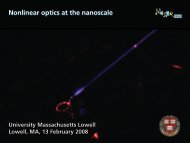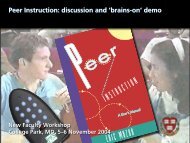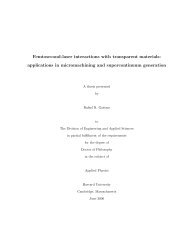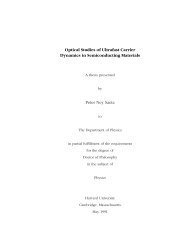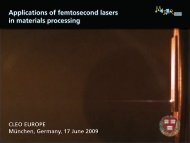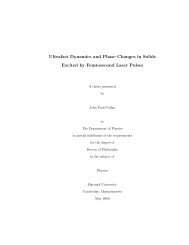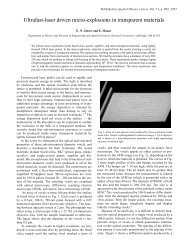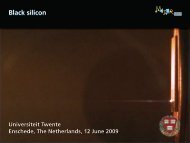How the mind tricks us: Visualizations and visual illusions
How the mind tricks us: Visualizations and visual illusions
How the mind tricks us: Visualizations and visual illusions
You also want an ePaper? Increase the reach of your titles
YUMPU automatically turns print PDFs into web optimized ePapers that Google loves.
<strong>How</strong> <strong>the</strong> <strong>mind</strong> <strong>tricks</strong> <strong>us</strong>:<strong>Visualizations</strong> <strong>and</strong> <strong>visual</strong> ill<strong>us</strong>ions19th International Conferenceon Technology in Collegiate Ma<strong>the</strong>maticsBoston, MA, 16 February 2007
<strong>How</strong> do we remember?
<strong>How</strong> do we remember?835-7663
A Quick Survey:• Three statements• Rate agreement• Scale 1–5: disagree = 1, agree = 5
Seeing is believing“Visual observations greatly help<strong>the</strong> underst<strong>and</strong>ing of material”1 = disagree, 5 = agree
Visualization is important“Memories of observations reinforce<strong>the</strong> retention of physical models”1 = disagree, 5 = agree
1 picture = 1000 words“Information can be transferred more quickly<strong>and</strong> more effectively <strong>visual</strong>ly than verbally”1 = disagree, 5 = agree
Instructions1. Add your scores2. Divide by 3 & round to nearest integer3. Enter your resultA = 1, B = 2, …, E=5
My messageThere is much to learn fromneurobiology <strong>and</strong> cognitive psychology
Outline• <strong>the</strong> physiology of seeing• cognitive issues related to seeing• learning from seeing
The physiology of seeing
Human vision• Small frequency range• Huge luminance range
10 8eye damage10 610 4outdoor, bright sunoutdoor, cloudyluminance (cd/m 2 )10 210 010 –2indoors, lit roomstreetlightoutdoor, full moon10 –4outdoor, starlight10 –6threshold for vision
10 8eye damageluminance (cd/m 2 )10 610 410 210 010 –2outdoor, bright sunoutdoor, cloudyindoors, lit roomstreetlightoutdoor, full moonoutdoor scene10 –4outdoor, starlight10 –6threshold for vision
10 8eye damageluminance (cd/m 2 )10 610 410 210 010 –2outdoor, bright sunoutdoor, cloudyindoors, lit roomstreetlightoutdoor, full moonoutdoor sceneprint10 –4outdoor, starlight10 –6threshold for vision
10 8eye damage10 6white10 4outdoor, bright sunoutdoor, cloudyblackAluminance (cd/m 2 )10 210 010 –2indoors, lit roomstreetlightoutdoor, full moonwhiteblackA10 –4outdoor, starlight10 –6threshold for vision
What <strong>the</strong> retina does:• Spatial compression• Adj<strong>us</strong>t luminance range to nerve S/N• Extract reflectance
Which is darker?A. <strong>the</strong> letter A is darkerB. <strong>the</strong> letter B is darkerC. both are <strong>the</strong> sameD. you’re tricking me; j<strong>us</strong>t tell meE. I’m conf<strong>us</strong>ed
Which is darker?A. <strong>the</strong> square marked A is darkerB. <strong>the</strong> square marked B is darkerC. both are <strong>the</strong> sameD. you’re tricking me; j<strong>us</strong>t tell meE. I’m conf<strong>us</strong>ed
darkequiluminantlightluminance = illumination + reflectance
Retinal cell organization• 10 8 receptors (rods <strong>and</strong> cones)• 10 6 ganglion cellsEach ganglion cell has a receptive fieldcontaining about 100 receptors
Retinal cell organizationcentersurroundReceptive field divided into two regions
Retinal cell responseDARKbaseline rate
Retinal cell responseabove baseline rateCenter excites
Retinal cell responsebelow baseline rateSurround inhibits
Retinal cell responsebaseline rateFull illumination same as no illumination
Center-surround antagonismluminance LdLdxcells respond to differences in intensity
Processing of <strong>visual</strong> information• 10 6 retinal ganglion cells• 100 impulses/s• that’s about 10 MB/s!<strong>How</strong> do we do it?
Visual pathways
Visual pathwaysretinaedgedetection
Visual pathwaysparallel pathways<strong>visual</strong>cortexcolor/luminanceleft/righttop/bottom
Visual pathwayshigher <strong>visual</strong>areasWHEREWHAT
Visual pathwayshigher <strong>visual</strong>areasWHEREcolor blindfastlow acuityhigh contrast sensitivitymotion perceptiondepth perceptionspatial organizationfigure/ground segregation
Visual pathwayshigher <strong>visual</strong>areascolor selectiveslowhigh acuitylow contrast sensitivityobject recognitionface recognitioncolor perceptionWHAT
Some points to keep in <strong>mind</strong>Luminance:• depth• motionColor:• form• function
Cognitive issues related to seeing
Visual pathwayscognitiveareasmemorymodelingWHEREWHAT
Mental modelsof behavior, events, workings are essential to• underst<strong>and</strong> our experiences• predict outcomes of our actions• h<strong>and</strong>le unexpected occurences
Mental models affect what we see
Mental tasks can prevent <strong>us</strong> from seeing
Number of passes?A. 13 (or less)B. 14C. 15D. 16E. 17 (or more)
Mental models override <strong>visual</strong> memory
Common misconceptionPlank evens out <strong>the</strong> load,so scale reading doesn’t change
Can we correct this misconceptionby showing <strong>the</strong> demonstration to students?
Presenting ineffective“As demonstrated in lecture both scales will read10 N regardless of where <strong>the</strong> center of mass is located. The platform <strong>and</strong> <strong>the</strong> metal block form oneunit that is being measured, so <strong>the</strong> scales showtwo evenly distributed readings, no matter where<strong>the</strong> metal block is placed along <strong>the</strong> platform.”
Remember?A. 835-6773B. 835-7336C. 853-7336D. 835-7663E. 853-6773
Remember?A. 835-6773B. 835-7336C. 853-7336D. 835-7663E. 853-6773
Facts vs. models835-7663TEL-ROOF
Observation can reinforce misconception!
M<strong>us</strong>t provide opportunity to revise model
<strong>How</strong>?• Predict outcome before observation• Record observation• Reconcile prediction with observation
Points to keep in <strong>mind</strong>• Mental models affect what we see• Mental tasks can prevent <strong>us</strong> from seeing• Mental models override <strong>visual</strong> memory
Learning from seeing
GoalHelp build (correct) models
Abstract vers<strong>us</strong> realistic• Abstract: highlight model• Realistic: connect to experience
Visualization typesill<strong>us</strong>trationanimationabstractconstantvelocityF by you, on crateF by floor, on craterealistic
Visualization typesill<strong>us</strong>trationanimationabstractconstantvelocity→F by you, on crate→F by floor, on craterealistic
Abstract vers<strong>us</strong> realisticUse:• photography/film when point canbe observed directly• abstract ill<strong>us</strong>tration/animation whenphenomenon is an abstraction(e.g., force or field)
Parabolic motion
A quick quizM. McCloskey, Intuitive PhysicsScientific American 248 (1983), pp. 122-130
A quick quizA B CWhich of <strong>the</strong> three paths shown (A–C) mostclosely resembles <strong>the</strong> path taken by <strong>the</strong> ball?
A quick quizA B CAnswer: B
A quick quizA B CAnswer: B
Even text book authors get <strong>the</strong> physics wrong!
MicrogravityWalker, 2nd Ed. (Prentice Hall, 2004)
MicrogravityWalker, 2nd Ed. (Prentice Hall, 2004)
Benson (Wiley, 1991)Microgravity
Benson (Wiley, 1991)Microgravity
Tipler, 1st Ed. (Worth, 1971)Ano<strong>the</strong>r classic
<strong>How</strong> not to shoot a monkeySears <strong>and</strong> Zemansky, 10th Ed. (Addison Wesley, 2000)
<strong>How</strong> not to shoot a monkeyHaliday, Resnick, Walker, 5th Ed. (Wiley, 1997)
<strong>How</strong> not to shoot a monkeyLea <strong>and</strong> Burke (Brooks/Cole, 1997)
<strong>How</strong> not to shoot a monkeyGiambattista, Richardson, Richardson (McGraw Hill, 2004)
The Clutter!
What do people look at?
Mazur (Prentice Hall, 200?)
Mazur (Prentice Hall, 200?)
Mazur (Prentice Hall, 200?)
Mazur (Prentice Hall, 200?)
Mazur (Prentice Hall, 200?)
Mazur (Prentice Hall, 200?)
People look at• Parabolic motion of ball• Carts
Serway <strong>and</strong> Jewett (Harcourt, 2002)
Serway <strong>and</strong> Jewett (Harcourt, 2002)
Wilson <strong>and</strong> Buffa, 5th Ed. (Prentice Hall, 2003)
Wilson <strong>and</strong> Buffa, 5th Ed. (Prentice Hall, 2003)
Jones <strong>and</strong> Childers, 3rd Ed. (McGraw Hill, 2001)
Jones <strong>and</strong> Childers, 3rd Ed. (McGraw Hill, 2001)
Sears <strong>and</strong> Zemansky (Addison Wesley, 2000)
Sears <strong>and</strong> Zemansky (Addison Wesley, 2000)
People look at• People• Text labels• O<strong>the</strong>r (distracting) elements
People look at• People• Text labels• O<strong>the</strong>r (distracting) elementsbut not <strong>the</strong> parabolic motion!
<strong>How</strong> can we effectively teach parabolic motion?
Measurements1.01.0horizongal position (m)0.80.60.40.2vertical position (m)0.80.60.40.200 10 20 30 40frame00 10 20 30 40frame1.020horizontal velocity (m/s)0.80.60.40.2verical acceleration (m 2 /s)1510500 10 20 30 40frame00 10 20 30 40frame
Summary• Color <strong>and</strong> luminance processed separately• Mental models & tasks affect what is seen• Realism can be problematic
Some things for you to ponder• My reality is not your reality• What you see depends on what you believe• We store models, not facts
AcknowledgmentsProf. Mazharin BanajiProf. Patrick CavanaghProf. Steven Franconeri (Northwestern)Rafael GattassJoanna HueyOlof JonmarkerProf. Margaret LivingstoneDr. Veronica McCauleyDr. Wolfgang RuecknerProf. Daniel Simons (UIUC)for a copy of this presentation see:http://mazur-www.harvard.edu




